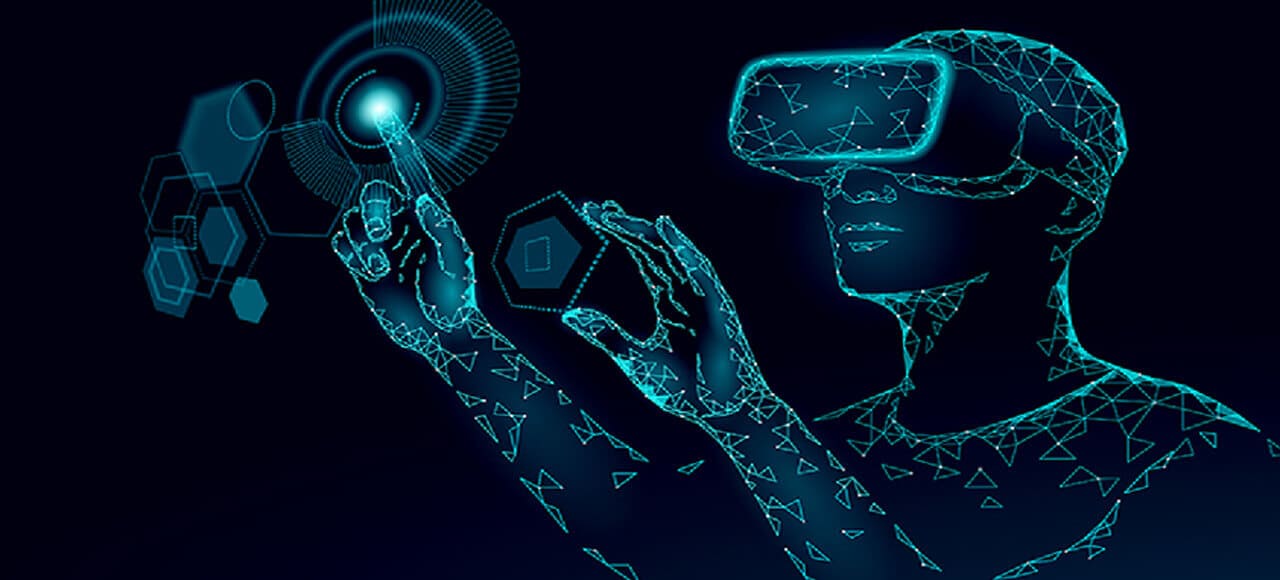A simulated 3D environment called virtual reality allows users to explore and interact with a virtual environment in a way that simulates reality as it is experienced by the users’ senses.
Although the environment is built using computer hardware and software, users may also need to put on accessories like helmets or goggles in order to interact with it.
Users are better able to suspend disbelief and treat a VR experience as genuine, even if it is fanciful, the more fully they can immerse themselves in it and shut out their actual surroundings.
What is virtual reality?
Virtual reality is a technology that allows users to experience a three-dimensional environment that is generated by computer software.
This technology can be used to create simulations of real-world environments, and can be used to create immersive experiences that allow users to feel as if they are inside of these simulations.
There are a number of applications for virtual reality technology, including gaming, education, and medical research which we will discussed later in this guide.
Primary forms of virtual reality
The VR industry still has a long way to go before achieving its goal of creating a fully immersive setting that allows users to experience a variety of feelings in a manner that is close to reality.
However, the technology has advanced significantly in terms of delivering a genuine sensory experience and has the potential for commercial use in a variety of areas.
Depending on their function and the technology used, VR systems may vary greatly from one to the next, but they often fall into one of the following three categories
1. Non-immersive
Typically, a 3D simulated world that can be accessed via a computer screen is what is meant by this kind of VR. Depending on the software, the surroundings could also produce sound.
Using a keyboard, mouse, or other device, the user may influence the virtual world to some extent, but the environment does not communicate with the user directly.
Non-immersive VR is exemplified by video games and websites that let users customize the look of a room.
2. Semi-immersive
Through a computer screen, a pair of glasses, or a headset, this kind of VR provides a limited virtual experience. It does not involve physical movement as full immersion does and instead concentrates on the visual 3D part of virtual reality.
The flight simulator, which is used by airlines and the military to train its pilots, is a typical example of semi-immersive VR.
3. Fully absorbed
The user has entirely submerged in the virtual 3D environment thanks to this form of VR, which offers the highest quality of virtual reality. It includes hearing, seeing, and sometimes touching.
Even some attempts with the addition of scent have been conducted.
Users are able to completely engage with their surroundings when they are wearing specialized gear like helmets, goggles, or gloves.
To give consumers the feeling of movement across the 3D world, the environment may also include items like treadmills or stationary bicycles.
Although fully immersive VR technology is still in its infancy, it has already had a significant impact on the gaming and, to a lesser degree, the healthcare industries, and it is sparking a lot of interest across a variety of other industries.
Virtual reality may also be described as collaborative VR. In this approach, individuals from various regions engage with one another virtually while each person is represented by a projected 3D character. Usually, the users speak to one another via headsets and microphones.
Although many would argue that it is a different but related discipline, augmented reality is also sometimes referred to as a sort of virtual reality. In augmented reality, virtual simulations are superimposed over actual settings to improve or supplement them.
For instance, a furniture company can provide a mobile app that lets customers use their phones to point at a space and see what a new chair or table would look like there.
Mixed reality, which combines the actual world and the virtual world into one setting, is another category that is sometimes seen as a subset of virtual reality.
However, it is often seen as a distinct but connected area, much like augmented reality. In fact, there is an increasing trend to refer to virtual reality, augmented reality, and mixed reality as all falling under the category of extended reality, which is a convenient way to refer to all three while keeping them distinct.
Numerous businesses and professionals are now pushing for more sophisticated metaverse applications as a result of current VR technology and applications.
Applications of virtual reality
Because the gaming industry has been at the forefront of the VR endeavor and because of the success of products like Beat Saber, Minecraft VR, and Skyrim VR, virtual reality is often connected with gaming.
However, there has been an increase in curiosity about VR possibilities in many other fields
1. Training
VR makes it feasible to teach staff members in a safe, effective, and economical manner. People in high-risk or highly specialized occupations, such as firemen, EMTs, police officers, soldiers, surgeons, or other medical staff, might particularly benefit from it.
2. Education
VR provides educational institutions with innovative teaching and learning techniques. While retaining their interest in the subject matter, it may provide students close access to settings that are generally unavailable. For instance, a history teacher may utilize virtual reality to take pupils back in time to ancient China or Greece.
3. Healthcare
Patients, healthcare professionals, and researchers might all gain from VR in the field of healthcare. VR, for instance, has the potential to cure conditions like anorexia, anxiety, or post-traumatic stress disorder (PTSD).
However, when working with patients to clarify diagnosis or treatment choices, clinicians may be able to employ VR. People with certain physical limitations may potentially benefit from VR.
4. Retail
Although VR has already had considerable success in the retail sector, there is still much room for growth. Customers will be able to try on clothing, design their houses, experiment with hairstyles, test eyeglasses, and generally make better selections about goods and services with the help of the correct applications.
5. Real estate
VR has several advantages for the real estate industry. For instance, building experts may virtually tour HVAC systems, house owners can see what their remodels will look like, and architects can display precise drawings in 3D.
6. Entertainment
Although VR has already had an influence on gaming, it also has the potential to completely change the film and television industries by giving viewers an immersive experience that immerses them in the action.
Virtual reality (VR) has the potential to create a whole business dedicated to tourism, allowing people to see locations they may never be able to visit in person.
The most basic kind of virtual reality is a 3D picture that can be interactively examined using a personal computer. Typically, this involves using the mouse or keyboard to move or zoom in and out of the image’s content.
More advanced initiatives include strategies like wraparound display displays, wearable device-enhanced physical spaces, or haptic devices that allow users to “feel” the virtual visuals.
Advantages and disadvantages of virtual reality:
When it comes to the idea of an artificial environment, there are as many questions as there are solutions. The virtual experience is much superior to the actual world in all areas, from gaming and entertainment to creativity and education.
That takes us to the point when it becomes challenging to maintain acceptance of reality. Here are some details to help you get acquainted with the benefits and drawbacks of virtual reality.
Advantages of virtual reality
1. Recovery and Healing
Veterans of the military and troops suffering from PTSD may benefit from this concept’s Virtual Reality technique. The simulations benefit the military patients by simulating real-life situations and allowing them to withstand incapacitating pressures.
By enabling individuals to comprehend the frightening surroundings better, virtual reality also aids in the reduction of phobias. Patients may improve their motor skills and physical therapy with the use of VR.
2. A hands-on learning experience
Virtual reality (VR) enables professionals and students to redesign challenging activities and projects that are even challenging to comprehend in real life.
Contrary to popular belief, virtual reality (VR) is also a useful tool for surgeons and medical professionals who want to better grasp the anatomy.
Additionally, VR significantly increases safety for the automotive and aviation industries. In order to prevent accidents, pilots get training via simulations. Aspiring drivers also receive instruction using VR for the same reasons.
3. Using VR to discover new locations
VR is a gift to every tech enthusiast in this ever-evolving world of technology. By being in one spot, virtual reality enables us to go to several locations throughout the world.
Imagine being able to explore a location for free via virtual reality while relaxing on your sofa. You may arrange a journey later after getting an overview of the location from the actual view.
4. VR Expands the Entertainment Horizon
It goes without saying what fantastic entertainment VR can provide you when you’re at home. The 3-D graphics are only an illustration of how exciting the gaming and live sports worlds may be to you.
Not only that, but you may also engage in exhilarating activities like skydiving, racing, and bungee jumping. So prepare for an adrenaline surge at home by sitting tight.
5. Participation and Communication
It is simpler to converse with other users within virtual reality worlds while using headgear. Since technology is at its best, making new pals is always possible.
Virtual reality therefore provides a variety of opportunities for interaction and openness, allowing you to communicate with others and share your experiences with those who are linked to you through social media.
What a great method to socialize with your pals in a virtual setting! Virtual reality social networking platforms are sufficient to upend your prior experiences.
Disadvantages of virtual reality
Every narrative has a twist that makes the storyline even more complex. There must be some terrible things about this technological revolution when it comes to virtual things.
This technical revolution is still taking place, as said. The drawbacks of virtual reality are listed below, along with several problems that need to be fixed.
1. You are isolated in real life by virtual reality
Let’s confront the one and only truth that will enable us to comprehend what Virtual Reality will bring. One would feel more alone the more time they spend in the virtual world.
Being less popular in society makes it difficult to express oneself in both public and private. A human’s ideal relationship with another human is formed via interpersonal relationships.
Virtual reality threats include cutting you off completely from the real world and your friends and family.
2. VR May Stress Your Eyes
Now let’s discuss health, which is also pretty upsetting to the eyes. The VR headsets that project two tiny LCD displays into each of your eyes are the ones that are the closest to your eyes.
Therefore, using a VR headset for an extended amount of time increases your chance of developing a variety of eye problems, including eye strain, which is a prevalent issue.
It happens when you concentrate on one thing for a long time, such when you watch a lengthy movie or spend all day looking at your computer or smartphone.
3. Limited Flexibility in Education
When a class just uses computer-based simulations, students’ mental flexibility and ability suffer. When responses are prepared and no cross-questions are posed, verbal contact between teachers and students decreases.
The real-time engagement is at its worst when both the instructor and the pupils are adhering to predetermined rules and directives. It’s important to remember that education cannot stop with programming software.
4. Virtual reality is sometimes buggy
A machine is a device that is susceptible to failure at any time. Every sort of user, including students and gamers, must deal with the inconvenience of a coded software that might go wrong at any time.
It can require some time and money to repair or fix the problem. Now imagine you have an exam the next morning and your headset malfunctions at the last minute.
5. Virtual reality is addictive
Users who already own VR headsets are likely to recognize the suffering associated with this addiction. As you spend more time in the actual world, you become increasingly cut off from reality and develop a VR addiction.
You have no idea how much time you have already squandered playing video games or how many hours you have accrued. You should remind yourself that everything is virtual and not really occurring. Now is the time to return to reality.
6. VR and eLearning
In a typical eLearning environment, students see graphics and text and interact by clicking, dragging, or entering text. Contrarily, virtual reality (VR) offers a far more immersive experience with information.
Virtual reality (VR) enables students to engage with the course content in a virtual setting. This increases engagement and, as a result, learning motivation.
Consider looking at a global map for a geography lesson, for instance. Not that intriguing, do you think? Consider the same lesson in a virtual reality setting where you may explore the world’s regions using a virtual globe. Isn’t it a lot more interesting?
Virtual reality has made it feasible to create new learning settings that weren’t before.
For instance, without actually being exposed to such an environment, one may design courses on how to operate in risky or dangerous locations, investigate with hazardous chemicals, or carry out other difficult tasks.
This provides practical experience with little risk of death. In addition to the pleasure and engagement factor, this safety component distinguishes VR as a unique advancement in the eLearning sector.
It enables students to make errors, learn from them, and attempt again until they have the necessary skill set. For instance, a VR-based hazardous material learning module will enable the student to practice handling the substance realistically without really running the danger of doing it incorrectly.
The future of VR (Virtual reality)
With the recent explosion of devices that support virtual reality, VR is swiftly gaining popularity. There are currently a number of VR apps available.
The prospect of training using virtual reality is exciting with its wide range of perspectives. Let’s have a look at some of the sectors where VR-based eLearning will have the most influence.
VR technology may be used extremely well in the medical and healthcare training sector to teach in processes and procedures. The virtual reality environment will let the student practice operations without worrying about how they could affect actual patients.
Training for technicians and machine operators is a crucial area where VR technology may transform education. With virtual reality, students may practice using machines in a safe environment before applying their skills to actual systems.
Compliance training is a further topic that is being researched and is presently available. In “safe” safety training, VR is widely employed. It enables trainees to encounter the repercussions of risky actions and transgressions of safety regulations.
Additionally, it helps students understand safety protocols exactly and obtain a sense of the situation they will really be in in real time.
In highly skilled occupations that need accuracy and practice, VR is also advantageous. In these situations, VR offers long-term economical advantages by removing the need to purchase practice materials and enabling learners to perform the activity as many times as necessary until they master it.
The intriguing field of virtual reality is already transforming e-learning. India’s eLearning businesses have correctly recognized the technology’s enormous potential and are using it to the maximum. Numerous studies are being conducted, and it is clear that VR will dominate the eLearning industry in the near future.
Conclusion
The future of virtual reality technology is covered in this lesson. Given advancements in technologies like smartphones and Internet technologies and as gadgets and technologies become more accessible and less expensive, the majority of studies indicate the potential of the technology that will be witnessed soon – in the range of 5 to 10 years.
VR has the potential to be a game-changer, but there are still issues that must be resolved before it can fully achieve its potential. Nevertheless, the benefits VR provides have already shown this.
Recommended articles:
What is cyber security? All you need to know about cyber security
Artificial intelligence | types, categories, applications, examples and goals
What is data science? All you need to know about data science
Robotic process automation (RPA), advantages and disadvantages
What is Edge Computing? Advantages and 4 main disadvantages of Edge Computing
What is Blockchain? How to become a blockchain developer and what to learn





Hi there great website! Does running a blog like this require a
large amount of work? I have absolutely no expertise in coding however I had been hoping to start my own blog
in the near future. Anyway, if you have any suggestions or techniques for new blog owners please share.
I understand this is off topic however I just wanted to
ask. Appreciate it!
Thanks & welcome. If you want to create a blog like this then please start as soon as possible. At the beginning, it is quite painful and boring. But you will obviously get the good result one day.
Thanks again!
Nice post. I learn something totally new and challenging on sites I stumble upon everyday.
It will always be interesting to read through articles from other authors and
use a little something from their web sites.
Heya i’m for the primary time here. I found this board and I find It truly helpful & it helped me out
a lot. I hope to offer one thing again and aid others such
as you aided me.